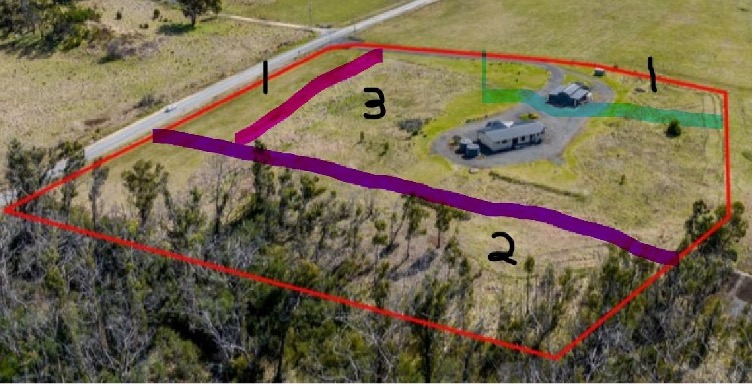
If your home is on more than 2 hectares (5 acres) you need to keep capital gains tax (CGT) records right from day one. This could even include lawn mowing fuel. Not hard just takes discipline and the right advice. Here is a link to spreadsheets and instructions that will help you get the job right with a minimum of fuss. https://www.bantacs.com.au/shop-2/cgt-record-keeping-and-tricks-for-homes-on-more-than-2-hectares/
The first step is to map out your property similar to the 7 acre property in the picture above. Google Earth Satellite Images will give you a bird’s eye view of your property. The snipping tool on windows will allow you to take a screen shop and drawn in the boundaries.
Main Residence – In this example the 3 acres in the middle will all be used for private purposes the whole time the property is owned so it will be exempt from CGT as the main residence. You need to apportion out the expenses associated with this area just the same so that they are not included in the area that will be subject to CGT. Seeing as you are going to that trouble you may as well record them in a spreadsheet just in case the main residence exemption is lost, for example selling the property while living overseas.
Place of Business – The 1 acre outlined in green will be used as a mechanical workshop with cars and machinery scattered around. If this area is used in the business by the owner or an associate (ie trading trust) for at least half the time the property is owned or 7 ½ years, which ever is the shortest, this 1 acre will qualify for the CGT small business concessions. These concession, with careful planning can result in the capital gain on that area being tax free and may even be able to be contributed to super with no contribution tax and without interfering with the other super caps.
No Use at All – The 1 acre outlined in pink while included on the title cannot be built on because one day it will be acquired by the government to widen the road. Nevertheless, it could be consider used for private purposes if it is say used to park cars or vegie gardens and so far only 3 of the 5 acres allowed have been used up. This is where the planning comes in from the start. What if these owners had instead fenced that area off and said not going to use it in any way. Well then it has not been used for private purposes so the main residence exemption does not apply. There is another option if caught in this situation. Ask a valuer if this land is worthless anyway. It maybe worthless when purchased so none of the purchase costs attributed to it and by the same token when the whole property is sold none of the sale proceeds are attributed to it either because it is still worthless, so while exposed to capital gains tax there is no capital gain.
Agistment – The 2 acres outlined in purple is going to be leased out on agistment to the neighbouring farmer. This makes the area income producing so it is not used for private purposes therefore cannot be covered by the main residence exemption. Further, it cannot be covered by the small business concessions either because agistment is not considered a business. As the whole 5 acres allowed under the main residence exemption has not been utilised the loss of the CGT concession for a small amount of agistment fees may not be worth it. You can’t even negative gear agistment fees. This is all an example of why it is important to get advice and make a plan right from the start.
This property could end up completely CGT free with the right planning. Have a valuer report that the 1 acre at the front is worthless now and when it is sold. Keeping all the capital gain to just 6 acres. Cover the one acre with the workshop with the small business concessions leaving just 5 acres. All of these 5 acres can be covered with the main residence exemption if they are used for private purposes and do not produce income, so no agistment. Maybe keep the grass down with pet goats. 😊
As a side issue you may be wondering what happens if the government does come along and acquire that one acre out the front. Well, our first problem would be if the government paid some money for it then it cannot be argued that the land was worthless when it was purchased and worthless when it was sold. Section 118-250 ITAA 1997 does provide a concession when this happens to an area of land that is covered by the main residence exemption, in that even though it is not sold with the dwelling it can utilise the main residence exemption. But of course you are left with the problem of another acre on the property not being able to be covered by the main residence exemption so it may still be worth exposing it to CGT depending on how your map works. Maybe argue that the value of the land was always what the government paid for it as there was no other option than to sell it to the government. That may help argue that acre’s share of the purchase price is the same as what the government paid for it. That way you can expose it to CGT but when all said and done, no actual capital gain.
 Julia's Blog
Julia's Blog